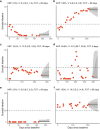Dynamic learning of individual-level suicidal ideation trajectories to enhance mental health care
- PMID: 38849429
- PMCID: PMC11161660
- DOI: 10.1038/s44184-024-00071-0
Dynamic learning of individual-level suicidal ideation trajectories to enhance mental health care
Abstract
There has recently been an increase in ongoing patient-report routine outcome monitoring for individuals within clinical care, which has corresponded to increased longitudinal information about an individual. However, many models that are aimed at clinical practice have difficulty fully incorporating this information. This is in part due to the difficulty in dealing with the irregularly time-spaced observations that are common in clinical data. Consequently, we built individual-level continuous-time trajectory models of suicidal ideation for a clinical population (N = 585) with data collected via a digital platform. We demonstrate how such models predict an individual's level and variability of future suicide ideation, with implications for the frequency that individuals may need to be observed. These individual-level predictions provide a more personalised understanding than other predictive methods and have implications for enhanced measurement-based care.
© 2024. The Author(s).
Conflict of interest statement
I.B.H. is the Co-Director, Health and Policy at the Brain and Mind Centre (BMC) The University of Sydney. The BMC operates an early-intervention youth service at Camperdown under contract to Headspace. He is the Chief Scientific Advisor to, and a 3.2% equity shareholder in, InnoWell Pty Ltd, which supports the transformation of mental health services internationally through the use of innovative technologies. E.S. is a Principal Research Fellow at the Brain and Mind Centre The University of Sydney. She is a Discipline Leader of Adult Mental Health, the School of Medicine, University of Notre Dame, and a Consultant Psychiatrist. She was the Medical Director, of the Young Adult Mental Health Unit, St Vincent’s Hospital Darlinghurst until January 2021. She has received honoraria for educational seminars related to the clinical management of depressive disorders supported by Servier, Janssen and Eli-Lilly Pharmaceuticals. She has participated in a national advisory board for the antidepressant compound Pristiq, manufactured by Pfizer. She was the National Coordinator of an antidepressant trial sponsored by Servier.
Figures



Similar articles
-
Right care, first time: a highly personalised and measurement-based care model to manage youth mental health.Med J Aust. 2019 Nov;211 Suppl 9:S3-S46. doi: 10.5694/mja2.50383. Med J Aust. 2019. PMID: 31679171
-
Factors affecting suicidal ideation among premenopausal and postmenopausal women.J Psychiatr Ment Health Nurs. 2021 Jun;28(3):356-369. doi: 10.1111/jpm.12679. Epub 2020 Aug 12. J Psychiatr Ment Health Nurs. 2021. PMID: 32738174
-
Blending Video Therapy and Digital Self-Help for Individuals With Suicidal Ideation: Intervention Design and a Qualitative Study Within the Development Process.JMIR Form Res. 2023 Sep 21;7:e49043. doi: 10.2196/49043. JMIR Form Res. 2023. PMID: 37733414 Free PMC article.
-
Association of Psychotic Experiences With Subsequent Risk of Suicidal Ideation, Suicide Attempts, and Suicide Deaths: A Systematic Review and Meta-analysis of Longitudinal Population Studies.JAMA Psychiatry. 2019 Feb 1;76(2):180-189. doi: 10.1001/jamapsychiatry.2018.3514. JAMA Psychiatry. 2019. PMID: 30484818 Free PMC article.
-
Decreasing suicide risk among patients with prostate cancer: Implications for depression, erectile dysfunction, and suicidal ideation screening.Urol Oncol. 2018 Feb;36(2):60-66. doi: 10.1016/j.urolonc.2017.09.007. Epub 2017 Sep 28. Urol Oncol. 2018. PMID: 28964659 Review.
Cited by
-
A prognostic model for predicting functional impairment in youth mental health services.Eur Psychiatry. 2024 Dec 19;67(1):e87. doi: 10.1192/j.eurpsy.2024.1787. Eur Psychiatry. 2024. PMID: 39697104 Free PMC article.
-
Personalized and collaborative use of digital measurement-based care tools enhances engagement among young adults: a mixed-methods study.BMC Health Serv Res. 2025 May 26;25(1):752. doi: 10.1186/s12913-025-12889-1. BMC Health Serv Res. 2025. PMID: 40420311 Free PMC article.
-
A Digital Approach for Addressing Suicidal Ideation and Behaviors in Youth Mental Health Services: Observational Study.J Med Internet Res. 2024 Dec 18;26:e60879. doi: 10.2196/60879. J Med Internet Res. 2024. PMID: 39693140 Free PMC article.
References
-
- Torous J, et al. Creating a digital health smartphone app and digital phenotyping platform for mental health and diverse healthcare needs: an interdisciplinary and collaborative approach. J. Technol. Behav. Sci. 2019;4:73–85. doi: 10.1007/s41347-019-00095-w. - DOI
-
- Jellins L. Assessment in the digital age: an overview of online tools and considerations for school psychologists and school counsellors. J. Psychol. Couns. Sch. 2015;25:116–125. doi: 10.1017/jgc.2015.8. - DOI
-
- Chung J, Buchanan B. A self-report survey: Australian Clinicians’ attitudes towards progress monitoring measures. Aust. Psychol. Soc. 2019;54:3–12. doi: 10.1111/ap.12352. - DOI
Grants and funding
LinkOut - more resources
Full Text Sources

